Canon CanoScan 8000F Review
Canon CanoScan 8000F
If you are into digital imaging, a scanner may well be regarded as a key peripheral for your set-up. If that’s so, the Canon CanoScan 8000F could be the unit you’re looking for.
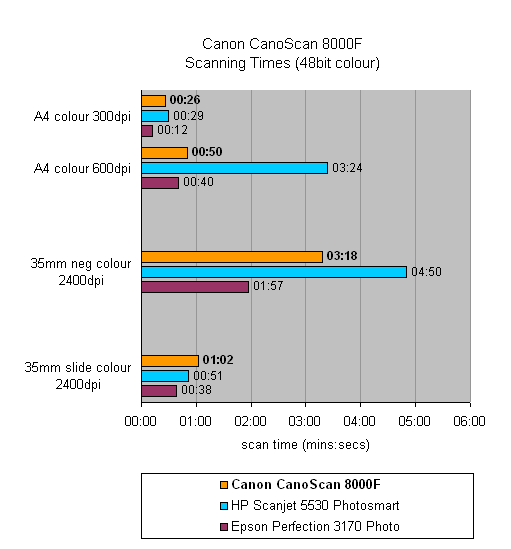
Verdict
Key Specifications
- Review Price: £129.00
Canon’s CanoScan 8000F flatbed scanner has been aimed squarely at the advanced home user who takes their imaging seriously. Like the other flatbed scanners we’ve previously reviewed (see opposite for our associated articles), the CanoScan 8000F features a transparency light source in the document lid and comes equipped with a film adapter unit that enables you to scan up to 12 frames of 35mm strip film or four mounted 35mm slides in one pass. Disappointingly there’s no option to scan medium format film, but when you consider the sub-£130 price tag (at the time of writing) then it’s difficult to complain.
The construction of the 8000F is of the high standard that you’d expect from Canon and I was generally impressed with its overall build quality and brushed metal lid. In my opinion, the only aspect of its design that falls a little short is the flimsy removable protective sheet that covers the light source in the lid. This basically hangs in place by way of four picture hook-type eyelets that look as if they’ll become worn over time. In addition, the design of the hinge on the 8000F’s lid allows easy scanning from large sources such as books or magazines. However, what sets this scanner apart from most other designs is its hardware based dust removal feature.
Anyone who’s ever scanned photos or transparent media at high resolutions will no doubt be aware that previously unseen dust particles or scratches are nearly always visible in the scanned image. Although many scanners nowadays are supplied with software to remove such artefacts from photos, the 8000F features Canon’s advanced FARE (Film Automatic Retouching and Enhancement) hardware technology. The FARE process uses infra-red light to identify dust and scratches before removing them from the final scanned image. The 8000F’s CCD sensor also incorporates diamond shaped pixels which Canon claims will improve the scanning accuracy of each element over the traditional square pixel design, particularly when enlarging small originals such as 35mm film.
Moving on, the 8000F supports 48-bit colour and offers an optical resolution of 2,400 x 4,800dpi. The only means of connectivity is via a USB2.0 interface (cable included) but this is compatible with both Windows and Macintosh operating systems. A helpful quick start guide is included in the box, which describes how to install the software and set up the scanner. Before using the 8000F for the first time, it’s important to remember to unlock the scanning unit using the switch located on the underside of the scanner. Likewise, the scanning unit should be locked again before moving or transporting the scanner in order to avoid mechanical damage.
The generous software bundle includes Adobe Photoshop Elements, ArcSoft PhotoStudio and PhotoBase, ScanSoft OmniPage SE and Presto! PageManager. On the front panel, the 8000F has four convenient scan buttons that allow you to copy (if you have a printer hooked up), produce an instant scan, generate a PDF file or scan directly to email. These buttons can also be manually reassigned to different scanning functions using the CanoScan Toolbox utility. Furthermore, the user interface on the TWAIN driver can be switched between a ‘Simple Mode’ that only allows you to adjust a few settings and an ‘Advanced Mode’ which offers complete control over how the final scanned image is produced.
Ultimately, it’s not all about what is bundled in the box and the key to a scanner’s success is in its scan performance and quality. In our timed tests, the 8000F completed our 48bit A4 colour scan test at 300dpi in 26 seconds which is slightly faster than the HP Scanjet 5530 we reviewed last month. At 600dpi, the 8000F took 50 seconds to scan the same area, which almost matches the speed of the nippy Epson Perfection 3170 Photo. The scanning times for colour slides and negatives are equally respectable although the Epson model is still the quickest of the three scanners we’ve tested so far.

The colour accuracy of the Canon scanner was also very good when scanning reflective media such as photos, with the resulting images showing a high level of detail. When using the film adapter unit to scan 35mm colour slides, the resulting images were just as impressive although in some cases an ever so slight red cast could be noticed. However, the 8000F was let down slightly by an overall lack of saturation in its colour negative scans. That said, we’ve seen this in other scanners and it just goes to show that scanners which offer some form of film scanning capability are no real match for a dedicated film scanner.
What was impressive, however, was the results obtained using the FARE dust and scratch removal feature mentioned earlier. Scanning a 35mm film with this function enabled did actually result in a cleaner image although the scan time can take longer. Admittedly, the process is not perfect and you may have to manually remove any remaining artefacts in an image manipulation package such as Adobe Photoshop. All the same, the FARE technology is definitely a worthwhile feature and not just a marketing gimmick.
”’Verdict”’
Thanks to its solid feature set and good image reproduction quality, the CanoScan 8000F is a flatbed scanner that should appeal to anyone who’s serious about digital imaging. Although not quite as accomplished as the Epson Perfection 3170 Photo, the 8000F’s keen price and overall performance equate to excellent value for money, and a recommendation.
(table:features)
Judging colour is a difficult task at the best of times. However, the overall tone and colour balance of the print and negative scans produced by the Canon CanoScan (below) look more realistic when compared to the HP model. Furthermore, the scan of the 35mm negative is almost on a par with that of the high quality Epson.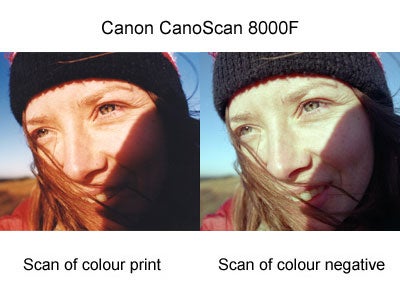
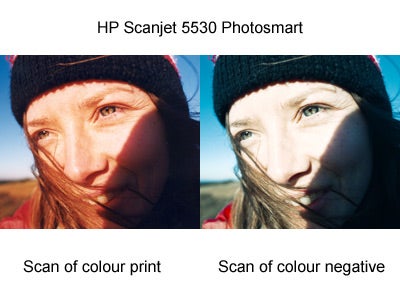
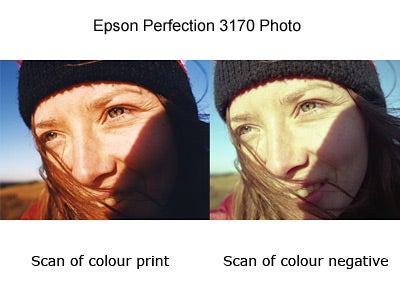
—-
This montage shows the level of definition you can expect from this scanner when it’s used to scan from colour negatives. The top picture is a scan of a professional print made from the same 35mm negative. In the picture below that, we can see that this scanner was able to resolve and retain the detail around the eye.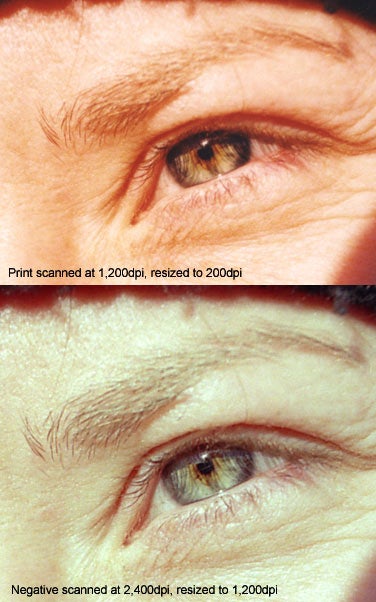
—-
This is a positive scan from a transparency/slide. Granted, this is a small version of the full scan, but it does give you an indication of the detail captured and the colour accuracy. The insert shows the quality of the scan at 100% resolution (ie. 2,400dpi). Once again the detail is very good with minimal signs of fuzziness or coloured fringing along the edges of the door mirror and the drivers’ fingers.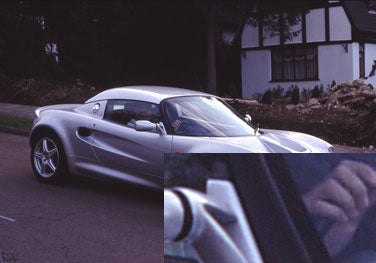
—-
The pictures below show a direct comparison between a 2,400dpi scan of a transparency produced by this scanner (top), the HP Scanjet 5530 Photosmart (middle) and the Epson Perfection 3170 Photo (bottom). Although a smidgen redder than the Epson scan, the Canon’s result looks sharper and clearly has the edge over the HP.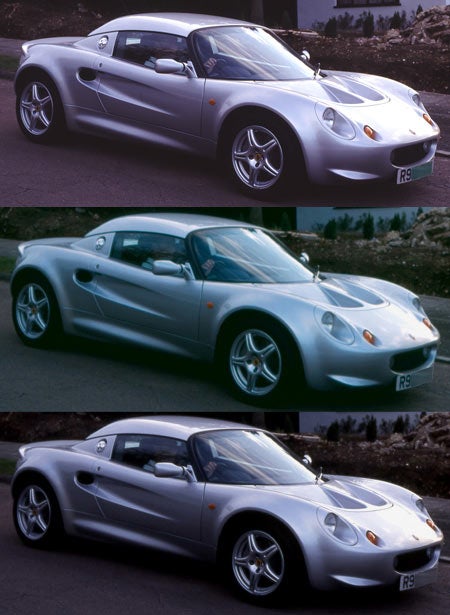
—-
Here we can see the capabilities of the ‘FARE’ feature. The top two images represent the whole 35mm negative scan and indicate where the bottom two pictures have been cropped out from. Notice how the artefacts have been successfully removed.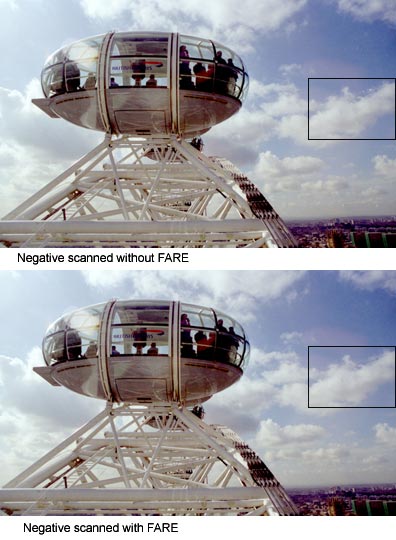
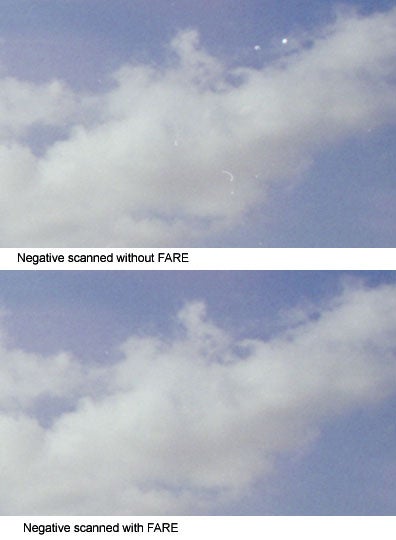
Trusted Score
Score in detail
-
Value 10
-
Image Quality 8

